child restraint Abarth 124 Spider 2021 Owner handbook (in English)
[x] Cancel search | Manufacturer: ABARTH, Model Year: 2021, Model line: 124 Spider, Model: Abarth 124 Spider 2021Pages: 224, PDF Size: 3.9 MB
Page 22 of 224
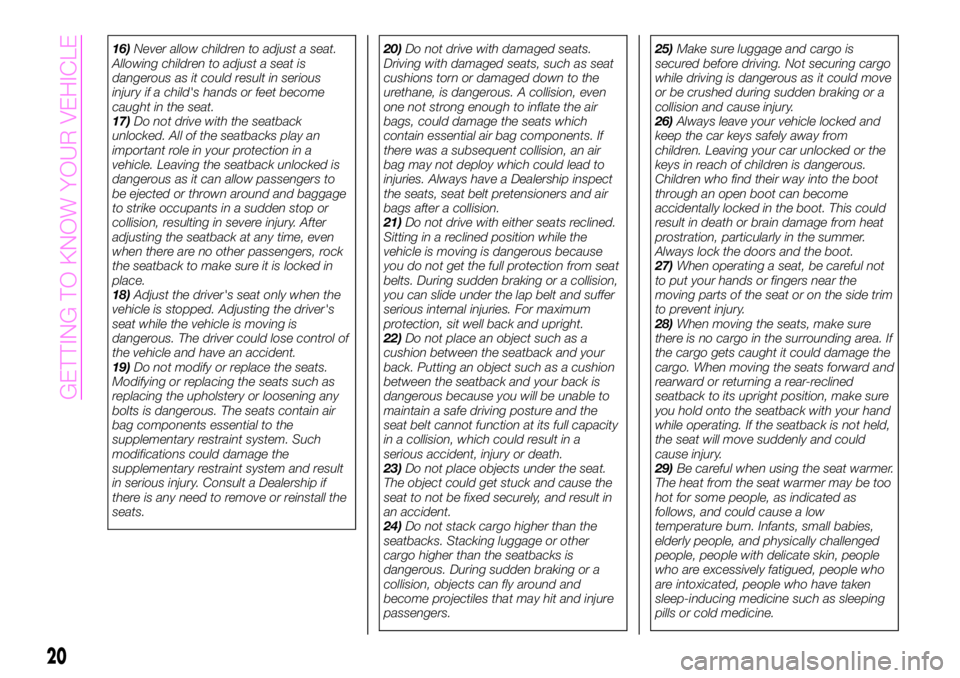
16)Never allow children to adjust a seat.
Allowing children to adjust a seat is
dangerous as it could result in serious
injury if a child's hands or feet become
caught in the seat.
17)Do not drive with the seatback
unlocked. All of the seatbacks play an
important role in your protection in a
vehicle. Leaving the seatback unlocked is
dangerous as it can allow passengers to
be ejected or thrown around and baggage
to strike occupants in a sudden stop or
collision, resulting in severe injury. After
adjusting the seatback at any time, even
when there are no other passengers, rock
the seatback to make sure it is locked in
place.
18)Adjust the driver's seat only when the
vehicle is stopped. Adjusting the driver's
seat while the vehicle is moving is
dangerous. The driver could lose control of
the vehicle and have an accident.
19)Do not modify or replace the seats.
Modifying or replacing the seats such as
replacing the upholstery or loosening any
bolts is dangerous. The seats contain air
bag components essential to the
supplementary restraint system. Such
modifications could damage the
supplementary restraint system and result
in serious injury. Consult a Dealership if
there is any need to remove or reinstall the
seats.20)Do not drive with damaged seats.
Driving with damaged seats, such as seat
cushions torn or damaged down to the
urethane, is dangerous. A collision, even
one not strong enough to inflate the air
bags, could damage the seats which
contain essential air bag components. If
there was a subsequent collision, an air
bag may not deploy which could lead to
injuries. Always have a Dealership inspect
the seats, seat belt pretensioners and air
bags after a collision.
21)Do not drive with either seats reclined.
Sitting in a reclined position while the
vehicle is moving is dangerous because
you do not get the full protection from seat
belts. During sudden braking or a collision,
you can slide under the lap belt and suffer
serious internal injuries. For maximum
protection, sit well back and upright.
22)Do not place an object such as a
cushion between the seatback and your
back. Putting an object such as a cushion
between the seatback and your back is
dangerous because you will be unable to
maintain a safe driving posture and the
seat belt cannot function at its full capacity
in a collision, which could result in a
serious accident, injury or death.
23)Do not place objects under the seat.
The object could get stuck and cause the
seat to not be fixed securely, and result in
an accident.
24)Do not stack cargo higher than the
seatbacks. Stacking luggage or other
cargo higher than the seatbacks is
dangerous. During sudden braking or a
collision, objects can fly around and
become projectiles that may hit and injure
passengers.25)Make sure luggage and cargo is
secured before driving. Not securing cargo
while driving is dangerous as it could move
or be crushed during sudden braking or a
collision and cause injury.
26)Always leave your vehicle locked and
keep the car keys safely away from
children. Leaving your car unlocked or the
keys in reach of children is dangerous.
Children who find their way into the boot
through an open boot can become
accidentally locked in the boot. This could
result in death or brain damage from heat
prostration, particularly in the summer.
Always lock the doors and the boot.
27)When operating a seat, be careful not
to put your hands or fingers near the
moving parts of the seat or on the side trim
to prevent injury.
28)When moving the seats, make sure
there is no cargo in the surrounding area. If
the cargo gets caught it could damage the
cargo. When moving the seats forward and
rearward or returning a rear-reclined
seatback to its upright position, make sure
you hold onto the seatback with your hand
while operating. If the seatback is not held,
the seat will move suddenly and could
cause injury.
29)Be careful when using the seat warmer.
The heat from the seat warmer may be too
hot for some people, as indicated as
follows, and could cause a low
temperature burn. Infants, small babies,
elderly people, and physically challenged
people, people with delicate skin, people
who are excessively fatigued, people who
are intoxicated, people who have taken
sleep-inducing medicine such as sleeping
pills or cold medicine.
20
GETTING TO KNOW YOUR VEHICLE
Page 74 of 224
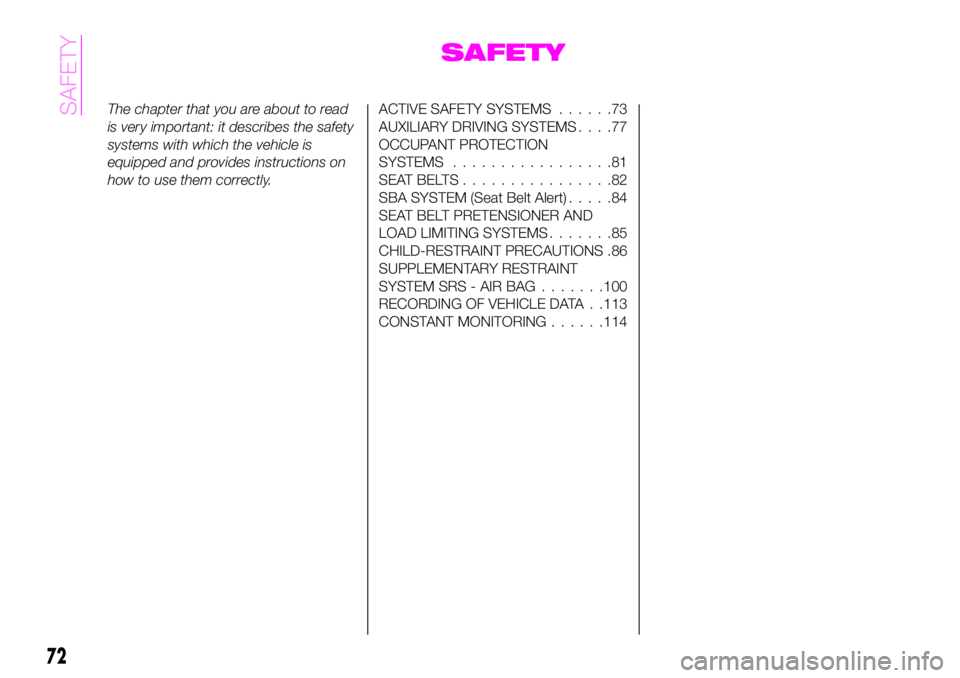
SAFETY
The chapter that you are about to read
is very important: it describes the safety
systems with which the vehicle is
equipped and provides instructions on
how to use them correctly.ACTIVE SAFETY SYSTEMS......73
AUXILIARY DRIVING SYSTEMS....77
OCCUPANT PROTECTION
SYSTEMS.................81
SEATBELTS................82
SBA SYSTEM (Seat Belt Alert).....84
SEAT BELT PRETENSIONER AND
LOAD LIMITING SYSTEMS.......85
CHILD-RESTRAINT PRECAUTIONS .86
SUPPLEMENTARY RESTRAINT
SYSTEM SRS - AIR BAG.......100
RECORDING OF VEHICLE DATA . .113
CONSTANT MONITORING......114
72
SAFETY
Page 83 of 224
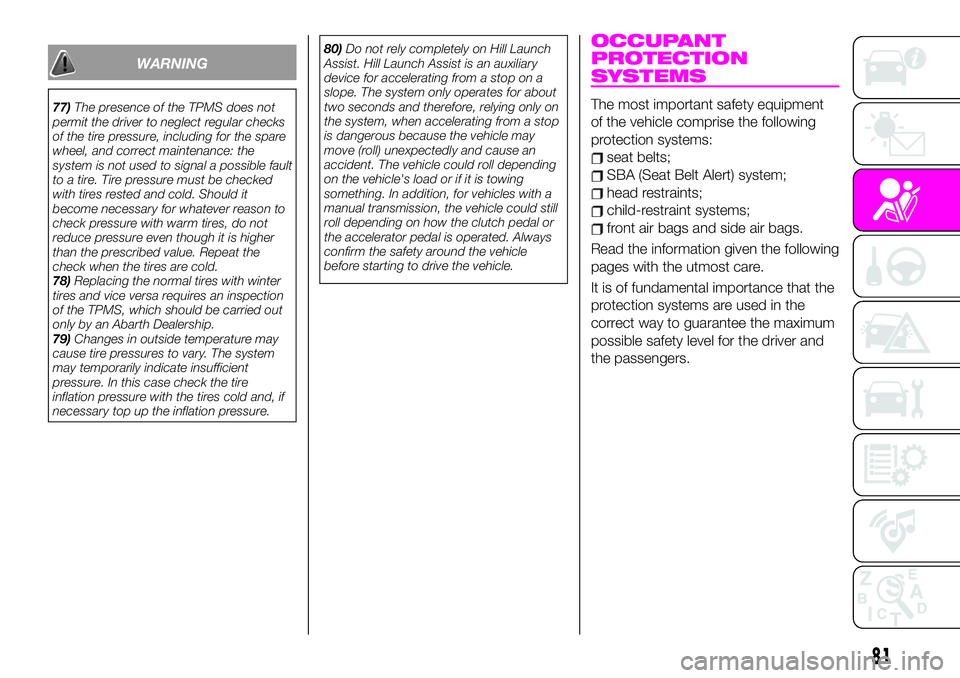
WARNING
77)The presence of the TPMS does not
permit the driver to neglect regular checks
of the tire pressure, including for the spare
wheel, and correct maintenance: the
system is not used to signal a possible fault
to a tire. Tire pressure must be checked
with tires rested and cold. Should it
become necessary for whatever reason to
check pressure with warm tires, do not
reduce pressure even though it is higher
than the prescribed value. Repeat the
check when the tires are cold.
78)Replacing the normal tires with winter
tires and vice versa requires an inspection
of the TPMS, which should be carried out
only by an Abarth Dealership.
79)Changes in outside temperature may
cause tire pressures to vary. The system
may temporarily indicate insufficient
pressure. In this case check the tire
inflation pressure with the tires cold and, if
necessary top up the inflation pressure.80)Do not rely completely on Hill Launch
Assist. Hill Launch Assist is an auxiliary
device for accelerating from a stop on a
slope. The system only operates for about
two seconds and therefore, relying only on
the system, when accelerating from a stop
is dangerous because the vehicle may
move (roll) unexpectedly and cause an
accident. The vehicle could roll depending
on the vehicle's load or if it is towing
something. In addition, for vehicles with a
manual transmission, the vehicle could still
roll depending on how the clutch pedal or
the accelerator pedal is operated. Always
confirm the safety around the vehicle
before starting to drive the vehicle.
OCCUPANT
PROTECTION
SYSTEMS
The most important safety equipment
of the vehicle comprise the following
protection systems:
seat belts;
SBA (Seat Belt Alert) system;
head restraints;
child-restraint systems;
front air bags and side air bags.
Read the information given the following
pages with the utmost care.
It is of fundamental importance that the
protection systems are used in the
correct way to guarantee the maximum
possible safety level for the driver and
the passengers.
81
Page 88 of 224
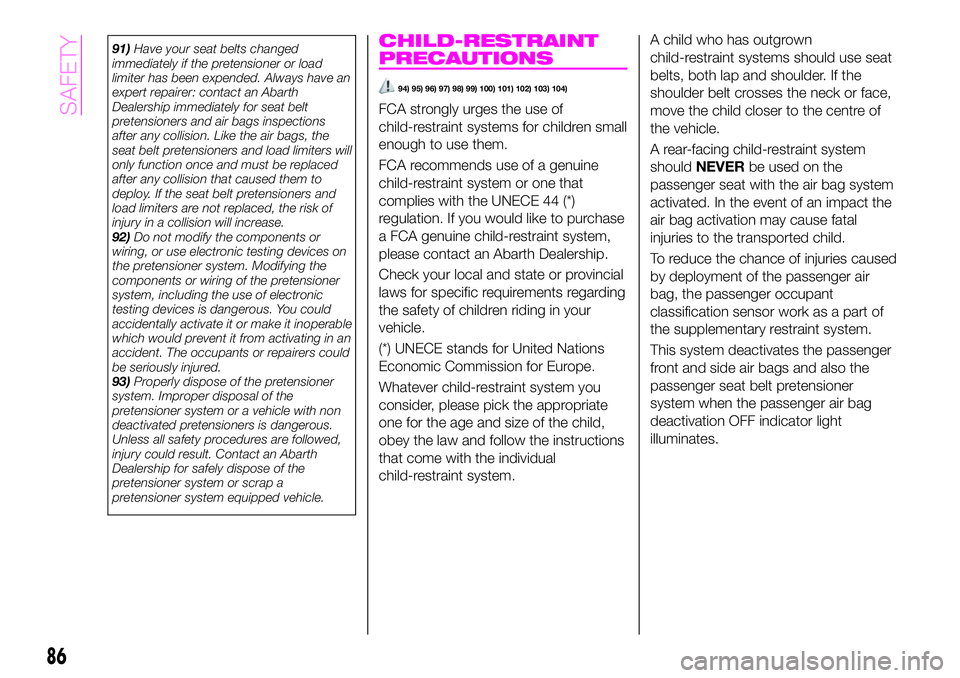
91)Have your seat belts changed
immediately if the pretensioner or load
limiter has been expended. Always have an
expert repairer: contact an Abarth
Dealership immediately for seat belt
pretensioners and air bags inspections
after any collision. Like the air bags, the
seat belt pretensioners and load limiters will
only function once and must be replaced
after any collision that caused them to
deploy. If the seat belt pretensioners and
load limiters are not replaced, the risk of
injury in a collision will increase.
92)Do not modify the components or
wiring, or use electronic testing devices on
the pretensioner system. Modifying the
components or wiring of the pretensioner
system, including the use of electronic
testing devices is dangerous. You could
accidentally activate it or make it inoperable
which would prevent it from activating in an
accident. The occupants or repairers could
be seriously injured.
93)Properly dispose of the pretensioner
system. Improper disposal of the
pretensioner system or a vehicle with non
deactivated pretensioners is dangerous.
Unless all safety procedures are followed,
injury could result. Contact an Abarth
Dealership for safely dispose of the
pretensioner system or scrap a
pretensioner system equipped vehicle.CHILD-RESTRAINT
PRECAUTIONS
94) 95) 96) 97) 98) 99) 100) 101) 102) 103) 104)
FCA strongly urges the use of
child-restraint systems for children small
enough to use them.
FCA recommends use of a genuine
child-restraint system or one that
complies with the UNECE 44 (*)
regulation. If you would like to purchase
a FCA genuine child-restraint system,
please contact an Abarth Dealership.
Check your local and state or provincial
laws for specific requirements regarding
the safety of children riding in your
vehicle.
(*) UNECE stands for United Nations
Economic Commission for Europe.
Whatever child-restraint system you
consider, please pick the appropriate
one for the age and size of the child,
obey the law and follow the instructions
that come with the individual
child-restraint system.A child who has outgrown
child-restraint systems should use seat
belts, both lap and shoulder. If the
shoulder belt crosses the neck or face,
move the child closer to the centre of
the vehicle.
A rear-facing child-restraint system
shouldNEVERbe used on the
passenger seat with the air bag system
activated. In the event of an impact the
air bag activation may cause fatal
injuries to the transported child.
To reduce the chance of injuries caused
by deployment of the passenger air
bag, the passenger occupant
classification sensor work as a part of
the supplementary restraint system.
This system deactivates the passenger
front and side air bags and also the
passenger seat belt pretensioner
system when the passenger air bag
deactivation OFF indicator light
illuminates.
86
SAFETY
Page 89 of 224
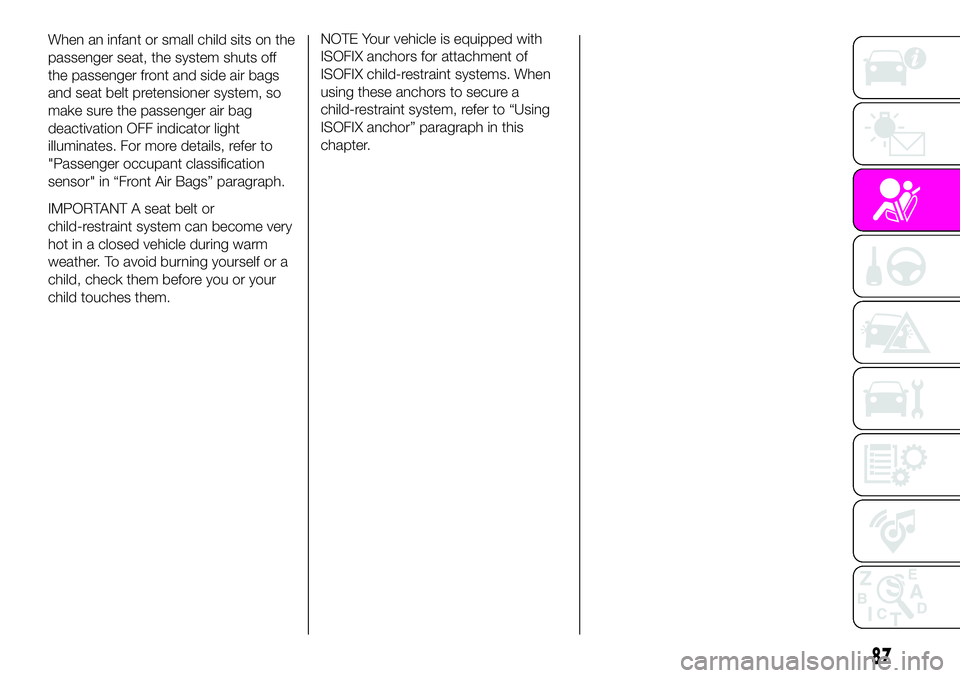
When an infant or small child sits on the
passenger seat, the system shuts off
the passenger front and side air bags
and seat belt pretensioner system, so
make sure the passenger air bag
deactivation OFF indicator light
illuminates. For more details, refer to
"Passenger occupant classification
sensor" in “Front Air Bags” paragraph.
IMPORTANT A seat belt or
child-restraint system can become very
hot in a closed vehicle during warm
weather. To avoid burning yourself or a
child, check them before you or your
child touches them.
NOTE Your vehicle is equipped with
ISOFIX anchors for attachment of
ISOFIX child-restraint systems. When
using these anchors to secure a
child-restraint system, refer to “Using
ISOFIX anchor” paragraph in this
chapter.
87
Page 90 of 224
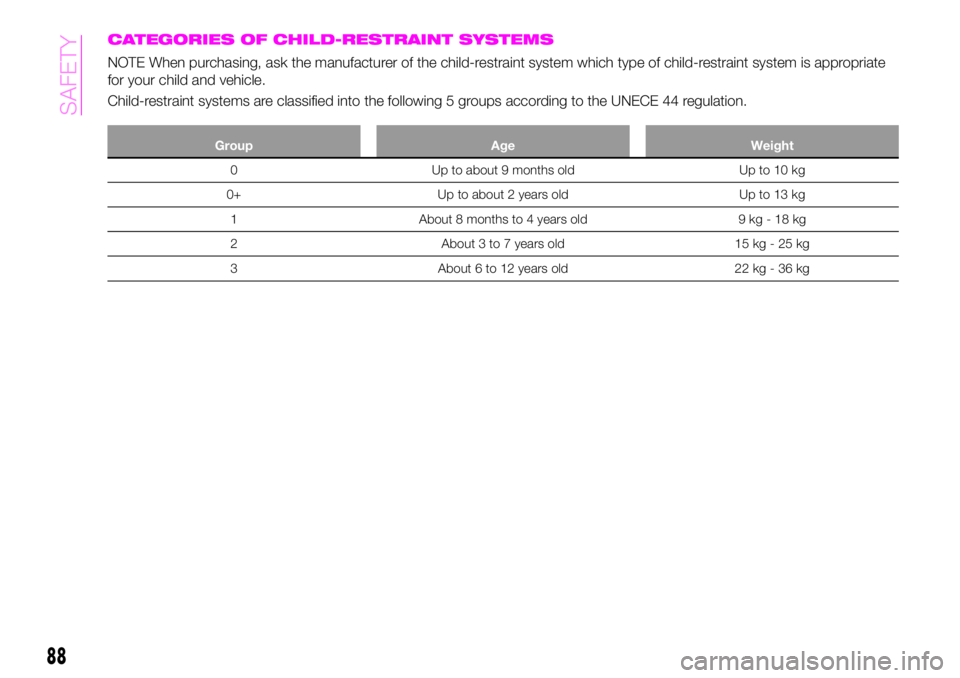
CATEGORIES OF CHILD-RESTRAINT SYSTEMS
NOTE When purchasing, ask the manufacturer of the child-restraint system which type of child-restraint system is appropriate
for your child and vehicle.
Child-restraint systems are classified into the following 5 groups according to the UNECE 44 regulation.
Group Age Weight
0 Up to about 9 months old Up to 10 kg
0+ Up to about 2 years old Up to 13 kg
1 About 8 months to 4 years old 9 kg - 18 kg
2 About 3 to 7 years old 15 kg - 25 kg
3 About 6 to 12 years old 22 kg - 36 kg
88
SAFETY
Page 91 of 224
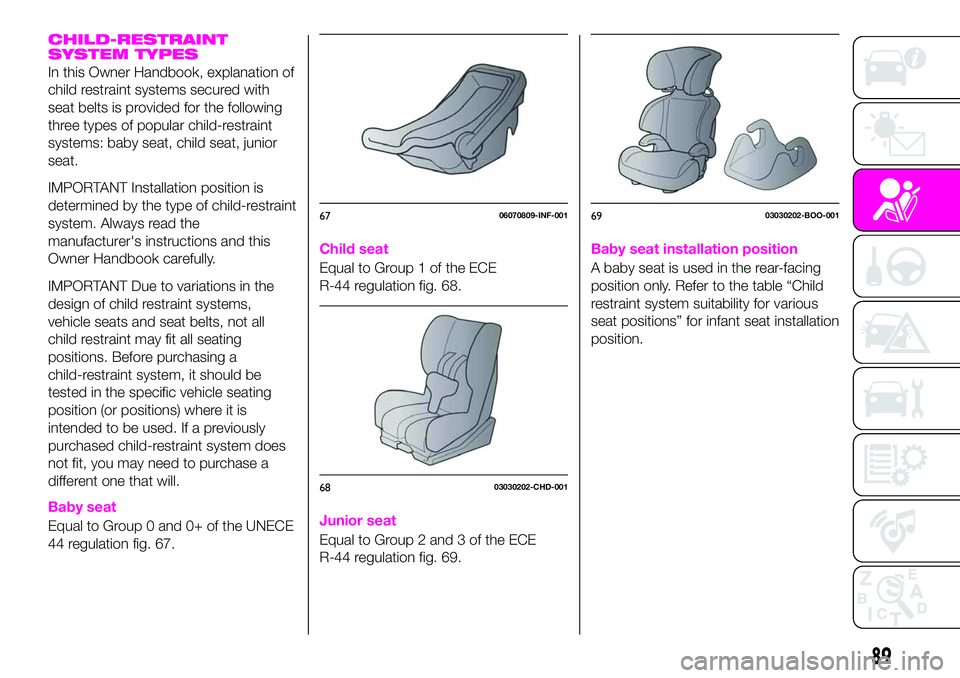
CHILD-RESTRAINT
SYSTEM TYPES
In this Owner Handbook, explanation of
child restraint systems secured with
seat belts is provided for the following
three types of popular child-restraint
systems: baby seat, child seat, junior
seat.
IMPORTANT Installation position is
determined by the type of child-restraint
system. Always read the
manufacturer's instructions and this
Owner Handbook carefully.
IMPORTANT Due to variations in the
design of child restraint systems,
vehicle seats and seat belts, not all
child restraint may fit all seating
positions. Before purchasing a
child-restraint system, it should be
tested in the specific vehicle seating
position (or positions) where it is
intended to be used. If a previously
purchased child-restraint system does
not fit, you may need to purchase a
different one that will.
Baby seat
Equal to Group 0 and 0+ of the UNECE
44 regulation fig. 67.
Child seat
Equal to Group 1 of the ECE
R-44 regulation fig. 68.
Junior seat
Equal to Group 2 and 3 of the ECE
R-44 regulation fig. 69.
Baby seat installation position
A baby seat is used in the rear-facing
position only. Refer to the table “Child
restraint system suitability for various
seat positions” for infant seat installation
position.
6706070809-INF-001
6803030202-CHD-001
6903030202-BOO-001
89
Page 92 of 224
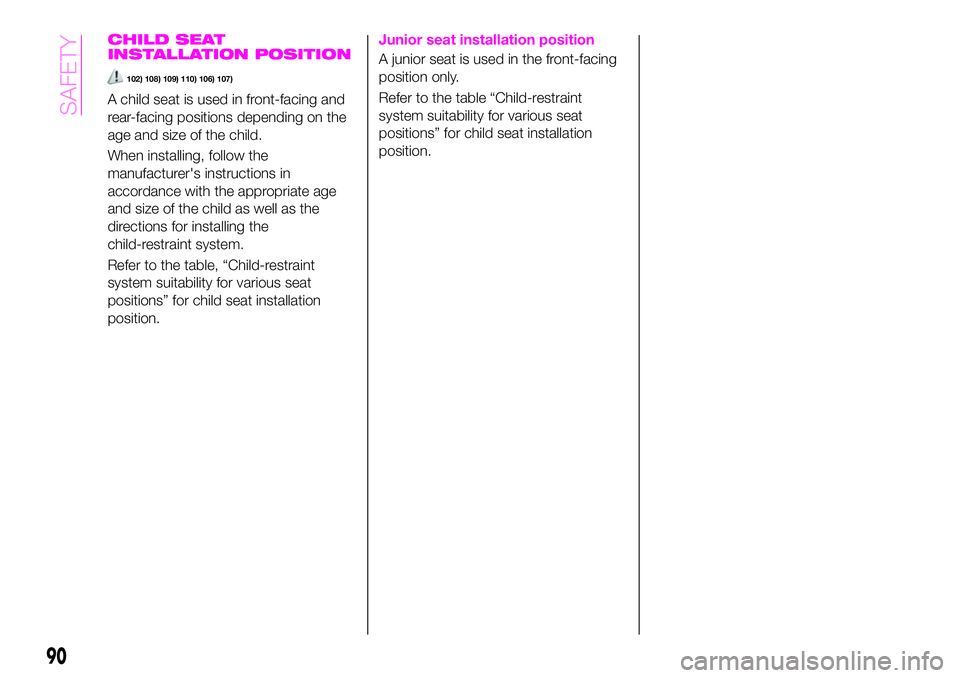
CHILD SEAT
INSTALLATION POSITION
102) 108) 109) 110) 106) 107)
A child seat is used in front-facing and
rear-facing positions depending on the
age and size of the child.
When installing, follow the
manufacturer's instructions in
accordance with the appropriate age
and size of the child as well as the
directions for installing the
child-restraint system.
Refer to the table, “Child-restraint
system suitability for various seat
positions” for child seat installation
position.
Junior seat installation position
A junior seat is used in the front-facing
position only.
Refer to the table “Child-restraint
system suitability for various seat
positions” for child seat installation
position.
90
SAFETY
Page 93 of 224
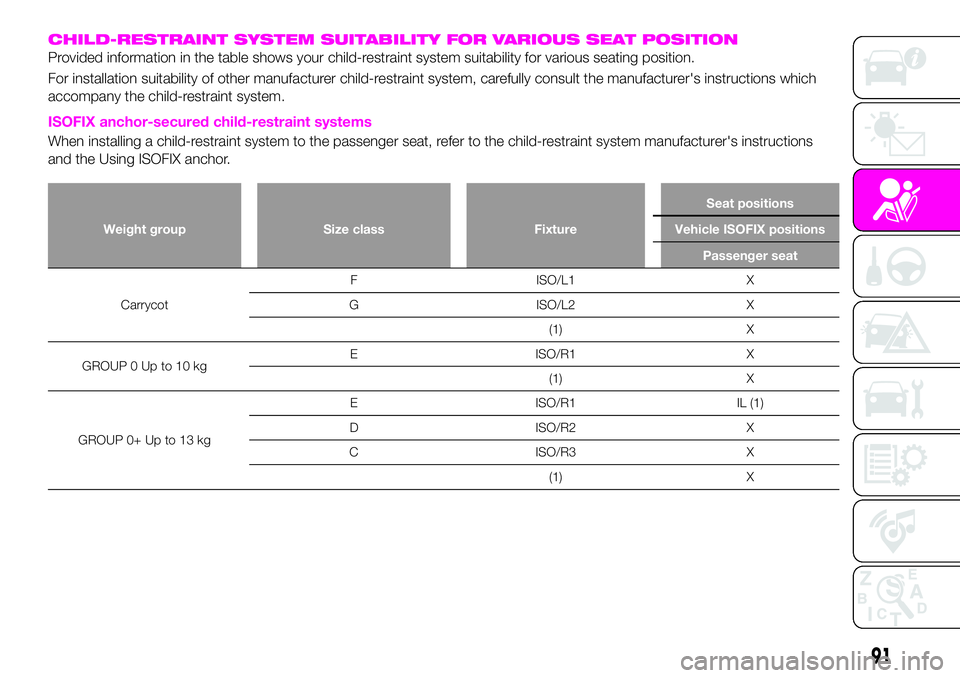
CHILD-RESTRAINT SYSTEM SUITABILITY FOR VARIOUS SEAT POSITION
Provided information in the table shows your child-restraint system suitability for various seating position.
For installation suitability of other manufacturer child-restraint system, carefully consult the manufacturer's instructions which
accompany the child-restraint system.
ISOFIX anchor-secured child-restraint systems
When installing a child-restraint system to the passenger seat, refer to the child-restraint system manufacturer's instructions
and the Using ISOFIX anchor.
Weight group Size class FixtureSeat positions
Vehicle ISOFIX positions
Passenger seat
CarrycotF ISO/L1 X
G ISO/L2 X
(1) X
GROUP 0 Up to 10 kgE ISO/R1 X
(1) X
GROUP 0+ Up to 13 kgE ISO/R1 IL (1)
D ISO/R2 X
C ISO/R3 X
(1) X
91
Page 94 of 224

Weight group Size class FixtureSeat positions
Vehicle ISOFIX positions
Passenger seat
GROUP19kg–18kgD ISO/R2 X
C ISO/R3 X
B ISO/F2 IUF
B1 ISO/F2X IUF
A ISO/F3 X
(1) IL (2)
GROUP 2 15 kg – 25 kg (1) IL (3)
GROUP 3 22 kg – 36 kg (1) IL (3)
(1) For the CRS which do not carry the ISO/XX size class identification (A to G), for the applicable weight group, the car
manufacturer shall indicate the vehicle specific ISOFIX child-restraint system(s) recommended for each position.
IUF = Suitable for ISOFIX forward child-restraints systems of universal category approved for use in this mass group.
IL = Suitable for particular ISOFIX child-restraint systems (CRS) given in the attached list.
These ISOFIX CRS are those of the “specific vehicle”, “restricted” or “semi-universal” categories.
(1) A CabrioFix child-restraint attached to an EasyFix Base, both sold by
MAXI-COSI®
can be installed.
(2) Pearl child-restraint attached to an FamilyFix Base, both sold by
MAXI-COSI®
can be installed.
(3)
BRITAX RÖMER®
KIDFIX can be installed (KIDFIX is no longer in production).
X = ISOFIX position not suitable for ISOFIX child-restraint systems in this mass group and/or this size class.
92
SAFETY